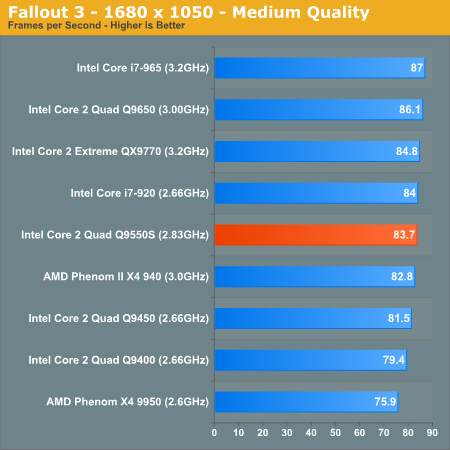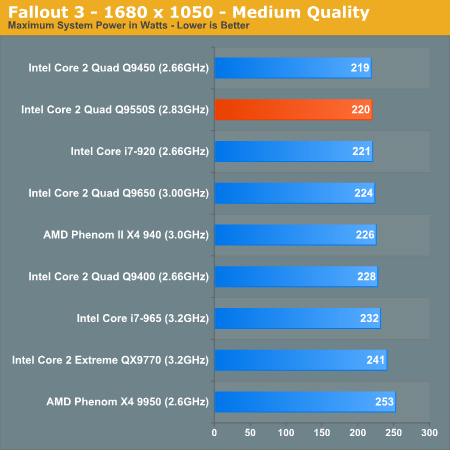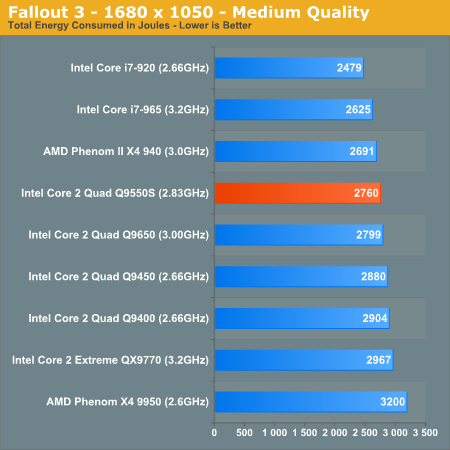Intel Core 2 Quad Q9550S: A New 65W Quad-Core
by Anand Lal Shimpi on January 27, 2009 8:00 PM EST- Posted in
- CPUs
Fallout 3 Game Performance
Bethesda’s latest game uses an updated version of the Gamebryo engine (Oblivion). This benchmark takes place immediately outside Vault 101. The character walks away from the vault through the Springvale ruins. The benchmark is measured manually using FRAPS.

Gaming performance here is pretty well clustered around the mid 80s.

With the GPU being the big driver of power consumption here, the CPUs themselves all use a similar amount of power. The variance between similarly clocked CPUs is normal between runs.
Peak power tells a similar story:


The energy efficiency graph is, however, unexpected. The Fallout 3 benchmark is a fixed time test; in other words, it takes the same amount of time to complete regardless of the system. With all benchmarks taking the same amount of time, total energy consumed should be dependent solely on average power. We’ve already seen that average power is pretty similar between the systems, so we should see some pretty even results here right?
Wrong.
While all of the Core 2 Quads consumed around 2800 - 2900J of energy the Core i7s used 2625J and 2479J for the 965 and 920, respectively. Remember that a feature of Core i7 is the ability to completely cut power to one of the cores if it’s not being used. This feature is thanks to Intel’s power gate transistors, which aren’t used in the Core 2 Quads. In a game where all four cores aren’t taxed, Core i7 can pull ahead in energy efficiency despite using a similar amount of power to the rest of the contenders.
The i7-920 actually uses less energy in this test than the lowest power quad-core Penryn we have on the chart.










62 Comments
View All Comments
carniver - Wednesday, January 28, 2009 - link
makes sense indeedAffenJack - Wednesday, January 28, 2009 - link
some results look strange like x264Phenom2, q9400 and q9450 have the same speed and same average power.
Shouldn't they have the same total energy comsumption?
I would say there's something wrong in this chart.
xahydra - Wednesday, January 28, 2009 - link
BeHardware reviewed the q9300 awhile back and tested consumption directly from the voltage rail and found it never pulled more than about 45 watts full load. This is consistent with the fact that the q9300 and its q8000 series cousins typically pull about 30W+ less than the q6600. Intels own processor information finder shows identical voltages for the 9300 and this "S" series CPU and the voltages are identical.. Only thing different is the stepping. Could the q9300 have been labeled as a 50W part had Intel cared to do so? Or even a 65W for that matter (giving margin of yield variation)?http://processorfinder.intel.com/details.aspx?sSpe...">http://processorfinder.intel.com/details.aspx?sSpe...
http://processorfinder.intel.com/details.aspx?sSpe...">http://processorfinder.intel.com/details.aspx?sSpe...
philosofool - Wednesday, January 28, 2009 - link
You're right that the Core i7 is overall a more efficient machine. However, the S series are LGA775 chips, which means that could fall into the upgrade path for many users, or simply be the chip of choice for someone interested in an $85 board and power friendly chip. It's the added premium of X58 and triple channel DDR3 memory that sets th Core i7 cost outside of the mainstream, not just the cost of the chip itself. Otherwise I'd be looking at a Core i7 machine right now....7Enigma - Wednesday, January 28, 2009 - link
I have a hard time wrapping my mind around a low(er) TDP part that cannot OC better than a non low TDP-binned processor? Is it just that the one you have for testing is a uniquely "gifted" cpu? It's my understand (correct me if I'm wrong) that lower TDP parts are due to superior construction that reduces leaks that would otherwise just go to heat production. If this is the case I can't see why a lower TDP part couldn't OC higher....Please enlighten me as it doesn't make a lot of sense. Oh and thanks for the review because I'm sure I'm not the only one that just assumed a lower TDP part would on average OC better than a higher TDP part.
JarredWalton - Wednesday, January 28, 2009 - link
Lower power parts can come from a variety of things, but binning is a major impact. In many cases, chips that need less voltage run cooler and OC better; likewise, chips that *can* run with less voltage can also run fine at higher speeds with a "normal" voltage. That puts Intel (and AMD) in the position of binning for several options: do you want a low power chip, a high default MHz chip, or some combination of the two?My guess would be that a lot of the QX9650/QX9770 and similar "extreme" CPUs can run at lower voltages and lower MHz. However, Intel might take CPUs that bin successfully at high clocks first, and then bin the remaining to see if some can run at lower voltage, which could then account for S-series chips that don't OC any better than regular chips.
Also remember that overclocking depends on many areas of the CPU, so it could be that these low voltage chips also tend to have limitations elsewhere -- maximum OC will always depend on the weakest link in the chip, which is why we see variability. Perhaps this being an ES chip has an impact, or it could just be random luck. Good or bad luck, that's the question.
I'm sure some S-series chips will overclock slightly better than regular Penryns, but at the end of the day the last 100-400 MHz really only matters to people running competitive benchmarks. Heck, I'm still running a Q6600@3.30GHz, and I have never encountered any situation where I think, "I wish my CPU had a little more oomph...." YMMV, naturally.
7Enigma - Friday, January 30, 2009 - link
Thank you for the very informative reply! And I agree it should make it into the original article to preempt the inevitable question.StraightPipe - Thursday, January 29, 2009 - link
Thanks. This is a great explaination.I wish it had made it into the main article.
WillR - Wednesday, January 28, 2009 - link
Anand, can you provide any further explanation why Intel’s power gate transistors gave the i7 a higher energy efficiency on the Fallout 3 test in terms of Joules but didn't actually give it a lower "at the wall" power draw in average watts? I'm just not following why it's making any difference in joules when it's not in watts (compared to the P2 940) if the dt is the same.Also, any interest in adding testing of the 50 watt Xeon L5420 to the benchmark database? Intel has had low voltage parts for almost a year, they just haven't brought them into the consumer products until now. For the most part they've been ignored by review sites.
DeepBlue1975 - Wednesday, January 28, 2009 - link
About the temperature advantage, I think the results are not trustworthy enough because there is no software that can accurately measure the absolute temperature of the cores.Even though Intel disclosed the tjunction max spec for their 45nm parts, they also said that the measure is not completely precise because each chip has a different tj max temperature that can not be read from any register.
Only i7's tj max can be obtained directly from the chip, so that the absolute core temperature can be better calculated.
Also on Intel's presentation, they stated that the DTS' readings are not accurate enough for measuring idle temps. Anyway this doesn't apply to this article as you're comparing mainly load temps, not idle ones, and when under load and the more the on die temp approaches tj max, the more accurate the DTS' reading becomes.
And as the Tcase temp is read and by a motherboard's sensor (at least AFAIK from the available Intel's docs), it isn't completely reliable either.
Aside from that, excellent article. Not many sites measure the "performance per watt" factor. The only thing I'd add to this article, is a direct comparison with a non-s 9550 e0 chip, specially in the overclocking department, as I tend to think that "cooler chips" will be actually most wanted by overclockers than by energy savers (mainly considering the high price premium)
Regards.